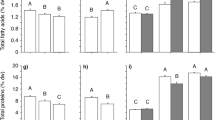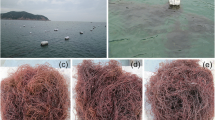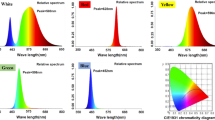Abstract
Late summer harvest of cultivated Saccharina latissima, prior to seasonally determined negative length growth, is considered advantageous in North Atlantic waters to optimize biomass yields. We hypothesized that seasonal increase in tissue protein and pigments over autumn and early winter would counterbalance the loss of biomass, and increase the absolute harvestable amount of protein and pigments. The hypothesis was tested in a land-based, factorial-designed, pilot-scale experiment using whole algae individuals exposed to naturally relevant high or low availability of nutrients and light. The experiment was conducted during fall/early winter in Grenaa, Denmark, in outdoor tanks, exposed to ambient light and temperature variations. With high nutrient availability, the absolute harvestable amounts of nitrogen, fucoxanthin, and chlorophyll a increased by 50.1–60.1, 21.7–53.7, and 47.0–73.5 %, respectively, despite a loss of biomass of 16.2–18.7 %. Under low nutrient availability, there was a net loss of biomass (8.1–9.5 %), tissue nitrogen (10.7–44.1 %), and fucoxanthin (7.1–17.2 %), and a minor increase in chlorophyll a (2.5–22.8 %). Nutrient availability had a significant negative impact on the biomass growth, but a positive control on the tissue concentration of nitrogen, chlorophyll a, and fucoxanthin. Our results, from a land-based experiment, indicate that early winter harvest of S. latissima biomass grown under high nutrient availability in Denmark, fulfills a higher degree of nutrient bioremediation, and has an improved biomass quality in regards of increased concentrations of pigments and nitrogen rich compounds.







Similar content being viewed by others
References
Adams JM, Gallagher JA, Donnison IS (2009) Fermentation study on Saccharina latissima for bioethanol production considering variable pre-treatments. J Appl Phycol 21:569–574
Adams JMM, Toop TA, Donnison IS, Gallagher JA (2011) Seasonal variation in Laminaria digitata and its impact on biochemical conversion routes to biofuels. Bioresour Technol 102:9976–9984
Ahn O, Petrell R, Harrison P (1998) Ammonium and nitrate uptake by Laminaria saccharina and Nereocystis luetkeana originating from a salmon sea cage farm. J Appl Phycol 10:333–340
Bartsch I, Wiencke C, Bischof K, Buchholz CM, Buck BH, Eggert A, Feuerpfeil P, Hanelt D, Jacobsen S, Karez R, Karsten U, Molis M, Roleda MY, Schubert H, Schumann R, Valentin K, Weinberger F, Wiese J (2008) The genus Laminaria sensu lato: recent insights and developments. Eur J Phycol 43:1–86
Black WAP (1950) The seasonal variation in weight and chemical composition of the common British Laminariaceae. J Mar Biol Assoc UK 29:45–72
Borum J, Pedersen MF, Krause-Jensen D, Christensen PB, Nielsen K (2002) Biomass, photosynthesis and growth of Laminaria saccharina in a high-arctic fjord, NE Greenland. Mar Biol 141:11–19
Bruhn J, Gerard VA (1996) Photoinhibition and recovery of the kelp Laminaria saccharina at optimal and superoptimal temperatures. Mar Biol 125:639–648
Cerna M (2011) Seaweed proteins and amino acids as nutraceuticals. Adv Food Nutr Res 64:297–312
Conolly NJ, Drew EA (1985) Physiology of Laminaria. III. Effect of coastal eutrophication on seasonal patterns of growth and tissue composition in L. digitata Lamour. and L. saccharina (L.) Lamour. Mar Ecol 6:181–195
D’Orazio N, Gemello E, Gammone MA, de Girolamo M, Ficoneri C, Riccioni G (2012) Fucoxantin: a treasure from the sea. Mar Drugs 10:604–616
Forbord S, Skjermo J, Arff J, Handå A, Reitan KI, Bjerregaard R, Lüning K (2012) Development of Saccharina latissima (Phaeophyceae) kelp hatcheries with year-round production of zoospores and juvenile sporophytes on culture ropes for kelp aquaculture. J Appl Phycol 24:393–399
Fortes MD, Lüning K (1980) Growth rates of North Sea macroalgae in relation to temperature, irradiance and photoperiod. Helgoländer Meeresun 34:15–29
Gerard VA (1988) Ecotypic differentiation in light-related traits of the kelp Laminara saccharina. Mar Biol 97:25–36
Gevaert F, Davoult D, Creach A, Kling R, Janquin MA, Seuront L, Lemoine Y (2001) Carbon and nitrogen content of Laminaria saccharina in the eastern English Channel: biometrics and seasonal variations. J Mar Biol Assoc UK 81:727–734
Gomez I, Wiencke C (1998) Seasonal changes in C, N and major organic compounds and their significance to morpho-functional processes in the endemic Antarctic brown alga Ascoseira mirabilis. Polar Biol 19:115–124
Grasshoff K, Erhardt M, Kremling K (1983) Methods of seawater analysis. Verlag Chemie, Weinheim
Handå A, Forbord S, Wang XX, Broch OJ, Dahle SW, Storseth TR, Reitan KI, Olsen Y, Skjermo J (2013) Seasonal- and depth-dependent growth of cultivated kelp (Saccharina latissima) in close proximity to salmon (Salmo salar) aquaculture in Norway. Aquaculture 414:191–201
Hansen JW (2013) Marine områder 2012. NOVANA. Videnskabelig rapport fra DCE - Nationalt Center for Miljø og Energi nr. 77. (in Danish)
Henley WJ, Dunton KH (1995) A seasonal comparison of carbon, nitrogen, and pigment content in Laminaria solidungula and L. saccharina (Phaeophyta) in the Alaskan arctic. J Phycol 31:325–331
Holdt SL, Edwards MD (2014) Cost-effective IMTA: a comparison of the production efficiencies of mussels and seaweed. J Appl Phycol 26:933–945
Holdt SL, Kraan S (2011) Bioactive compounds in seaweed: functional food applications and legislation. J Appl Phycol 23:543–597
Jimenez-Escrig A, Jimenez-Jimenez I, Pulido R, Saura-Calixto F (2001) Antioxidant activity of fresh and processed edible seaweeds. J Sci Food Agric 81:530–534
Kopsell DA, Kopsell DE, Curran-Celentano J (2007) Carotenoid pigments in kale are influenced by nitrogen concentration and form. J Sci Food Agric 87:900–907
Lambers H, Chapin FS, Pons TL (2008) Plant physiological ecology. Springer, New York
Lobban CS, Harrison PJ (1994) Seaweed Ecology and Physiology. Cambridge university press, Cambridge
Lüning K, Pang SJ (2003) Mass cultivation of seaweeds: current aspects and approaches. J Appl Phycol 15:115–119
Marinho G, Holdt S, Birkeland M, Angelidaki I (2015) Commercial cultivation and bioremediation potential of sugar kelp, Saccharina latissima, in Danish waters. J Appl Phycol:1–11. doi:10.1007/s10811-014-0519-8
Nielsen M, Krause-Jensen D, Olesen B, Thinggaard R, Christensen P, Bruhn A (2014) Growth dynamics of Saccharina latissima (Laminariales, Phaeophyceae) in Aarhus Bay, Denmark, and along the species’ distribution range. Mar Biol 161:2011–2022
Pang JS, Lüning K (2004) Breaking seasonal limitation: year-round sporogenesis in the brown alga Laminaria saccharina by blocking the transport of putative sporulation inhibitors. Aquaculture 240:531–541
Parke M (1948) Studies on British Laminariaceae. I. Growth in Laminaria saccharina (L.). Lamour. J Mar Biol Assoc U K 27:651–709
Peteiro C, Freire O (2009) Effect of outplanting time on commercial cultivation of kelp Laminaria saccharina at the southern limit in the Atlantic coast, N.W. Spain. Chin J Oceanol Limnol 27:54–60
Peteiro C, Freire O (2013a) Epiphytism on blades of the edible kelps Undaria pinnatifida and Saccharina latissima farmed under different abiotic conditions. J World Aquacult Soc 44:706–715
Peteiro C, Freire Ó (2013b) Biomass yield and morphological features of the seaweed Saccharina latissima cultivated at two different sites in a coastal bay in the Atlantic coast of Spain. J Appl Phycol 25:205–213
Quinn GP, Keough MJ (2002) Experimental design and data analysis for biologists. Cambridge University Press, Cambridge
Roleda MY, Dethleff D (2011) Storm-generated sediment deposition on rocky shores: Simulating burial effects on the physiology and morphology of Saccharina latissima sporophytes. Mar Biol Res 7:213–223
Rosell K-G, Srivastava LM (1985) Seasonal variation in total nitrogen, carbon and amino acids in Macrocystis integrifolia and Nereocystis luetkeana (Phaeophyta). J Phycol 21:304–309
Sanderson JC, Dring MJ, Davidson K, Kelly MS (2012) Culture, yield and bioremediation potential of Palmaria palmata (Linnaeus) Weber & Mohr and Saccharina latissima (Linnaeus) C.E. Lane, C. Mayes, Druehl & G.W. Saunders adjacent to fish farm cages in northwest Scotland. Aquaculture 354–355:128–135
Schmedes PS, Boderskov T (2013) Cultivation of two kelp species, Laminaria digitata and Saccharina latissima, in Danish waters - geographic variation in growth and biochemical composition. Masters thesis, Århus University, Denmark
Scoggan J, Zhimeng Z, Feijiu W (1989) Culture of kelp (Laminaria japonica) in China. FAO Training Manual 89/5 (RAS/86/024), Electronic edition. Available at: http://www.fao.org/docrep/field/003/AB724E/AB724E00.htm
Soler-Vila A, Coughlan S, Guiry MD, Kraan S (2009) The red alga Porphyra dioica as a fish-feed ingredient for rainbow trout (Oncorhynchus mykiss): effects on growth, feed efficiency, and carcass composition. J Appl Phycol 21:617–624
Acknowledgments
This study was conducted as a part of the “MacroAlgae Biorefinery” (MAB3) project funded by The Danish Council for Strategic Research (DSF), as well as “Seaweed for polishing of waste water” funded by The Foundation for Development of Technology of the Danish Water Sector (VTU-fonden). We thank Kitte Linding Gerlich and Tanja Quottrup Egholm for their valuable guidance and assistance in the laboratory, and Peter M. Kofoed for carrying out the CN analyses.
Author information
Authors and Affiliations
Corresponding author
Rights and permissions
About this article
Cite this article
Boderskov, T., Schmedes, P.S., Bruhn, A. et al. The effect of light and nutrient availability on growth, nitrogen, and pigment contents of Saccharina latissima (Phaeophyceae) grown in outdoor tanks, under natural variation of sunlight and temperature, during autumn and early winter in Denmark. J Appl Phycol 28, 1153–1165 (2016). https://doi.org/10.1007/s10811-015-0673-7
Received:
Revised:
Accepted:
Published:
Issue Date:
DOI: https://doi.org/10.1007/s10811-015-0673-7




